Zhang Hao: evaluation and application of UVA led photocatalysis technology for air sterilization and disinfection
From: China Lighting Network
At present, the novel coronavirus is still continuing, which has a certain degree of impact on industry and enterprises, and also affects people's hearts in all walks of life. In this situation, under the guidance of the national semiconductor lighting engineering research and development and Industry Alliance and the third generation semiconductor industry technology innovation strategic alliance, China semiconductor lighting network and Jizhi headlines have started knowledge sharing during the epidemic period to help enterprises solve their doubts. Help our LED lighting enterprises and industries overcome difficulties together!
In this issue, we invited Zhang Hao, deputy general manager of Guangdong yuenengjing Environmental Protection Technology Co., Ltd., to share the wonderful theme of "evaluation and application of air sterilization and disinfection of UVA led photocatalysis technology"
1、 Brief introduction of photocatalytic technology
The discovery of photocatalysis came from 1972, when fujishimaki of Tokyo University first discovered that irradiated titanium dioxide (TiO2) can produce hydrogen by continuous oxidation-reduction reaction of water. This effect is known worldwide as the "Honda Fujishima effect," which combines the names of Professor Fujishima and his then instructor, Kenichi bendo, President of Tokyo Institute of technology.
1. Introduction of photocatalytic technology
(1) Photocatalysis is a new interdisciplinary research field of catalytic chemistry, photoelectrochemistry, semiconductor physics, materials science and environmental science;
(2) Under the excitation of ultraviolet light (wavelength less than 380nm), photogenerated electrons and electron holes are produced in semiconductors;
(3) The capacity of the electron hole reaches 3.0ev, which is equivalent to the energy of 15000 ℃
(4) Photogenerated electrons have reductive properties, which can reduce aquatic hydrogen and directly generate electricity - solar cells - energy utilization;
(5) Photogenerated holes have strong oxidation, can degrade or mineralize pollutants, kill bacteria and viruses - environmental applications.
Oxidizability: F2 > oh > O3 > H2O2 > MnO4 - > Cl2
Photocatalytic technology can effectively degrade almost all organic compounds
Mineralization of sulfur, nitrogen and phosphorus compounds
Efficient sterilization
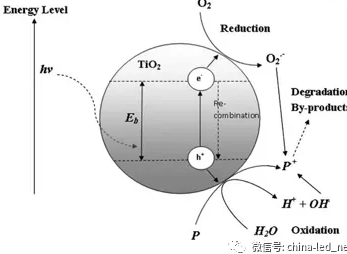
2. Principle of photocatalytic sterilization
The hydroxyl radicals and active ionic oxygen produced by photocatalyst can oxidize bacteria and viruses
Coenzyme A oxidation mechanism, cell wall (membrane) damage mechanism, DNA & amp; RNA genetic material damage mechanism
Photocatalytic sterilization has the advantages of durability, broad spectrum, heat resistance, no drug resistance and thorough sterilization. It also has the advantages of non-toxic, tasteless, no irritation to the skin, no consumption, and can be reused.
It is worth noting that after inactivation of bacteria and viruses, the remains of bacteria and viruses are composed of basic elements, and photocatalysis can efficiently decompose and remove the residual corpses. There is a kind of endotoxin in medicine, which can be decomposed by photocatalysis.

There are many kinds of literatures about photocatalytic sterilization, including tuberculosis, hepatitis B, conventional bacteria, viruses, etc. there are no problems in the mechanism, application and laboratory demonstration.
2、 Evaluation of photocatalytic effect
As for the evaluation, there will be the problem of standards. Compared with international standards, the domestic standards on photocatalysis are not perfect at present. In air purification, water purification, self-cleaning of photocatalytic materials, anti-virus, UV light source for photocatalysis and so on, there are few standards, and they are not compulsory standards. In particular, the purple part does not include LED UV light source.
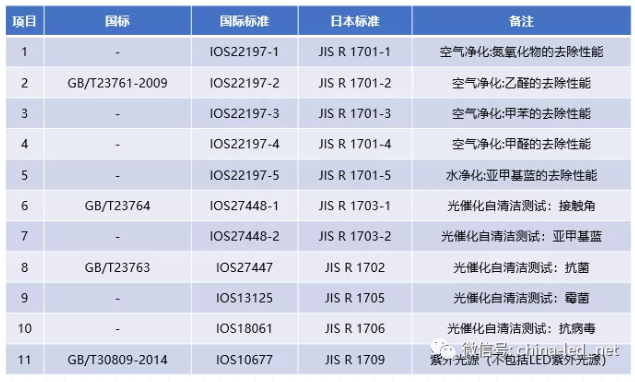
There is a big gap between the actual test conditions and the actual test conditions of the national standard, including the test conditions of the actual test conditions.
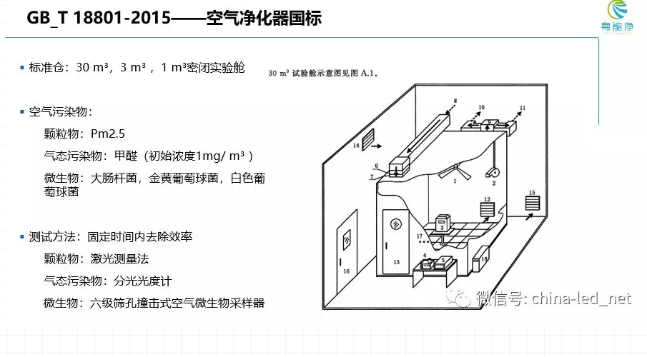
From the point of view of YUENENG, according to the national standard of air purifier, we designed our own photocatalytic reactor
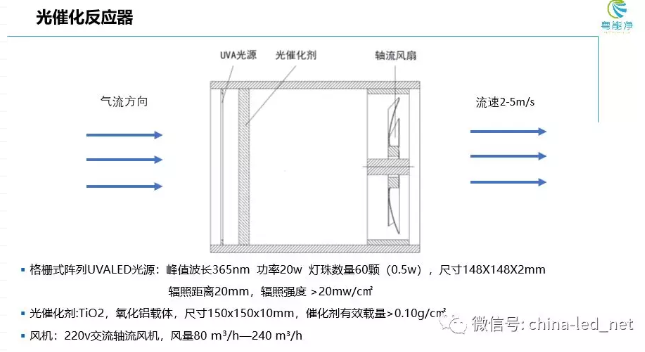
Through such a reactor, we tested some formaldehyde in a laboratory cube, then bacteria, and then viruses. On the basis of sufficient data, all kinds of adaptation of catalyst to light source were carried out. After stabilization, turn it into a standard photocatalytic unit and put it into our purification equipment to detect the actual use level of purifier or disinfector.
It is worth mentioning that the formaldehyde degradation efficiency in a cubic warehouse can exceed 90% in one hour. It should be noted that you may have a certain understanding of photocatalysis and photocatalysis, and you may have seen many reports. Among them, one value must not be ignored, that is, the action time. Some manufacturers can achieve more than 99% photocatalyst in the test, but the efficiency will be very low if the action time exceeds 24 hours, or even reaches 48 hours or 72 hours.
Since then, we have done other harmful gas tests, such as benzene, xylene and so on. Typical odor representatives include ammonia, sulfur dioxide, hydrogen sulfide, etc., which have a solid experimental basis and data support for photocatalytic materials to remove industrial waste gas and deodorization. Some tests have been done for bacteria, and the effect is also very good.
The structure of mass production equipment is very simple, and the equipment made of it has high killing efficiency for Staphylococcus albus and H3N2 influenza virus.
Structure of photocatalytic air treatment equipment
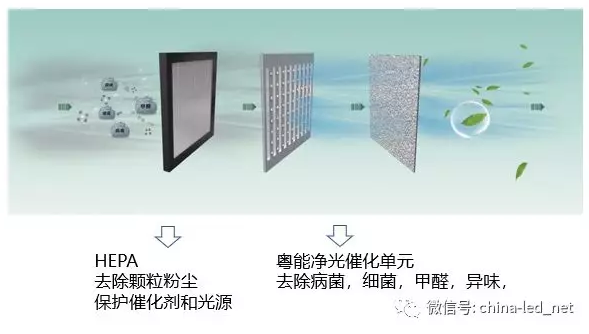
3、 Comparison of existing UV sterilization technologies
In the ultraviolet part, there are actually two reactions of ultraviolet photolysis and ultraviolet photogeneration of ozone. Because the shorter the UV wavelength and the higher the frequency, the greater the energy brought by the light wave itself. Once this energy is greater than the energy between organic compounds or compounds or cell bonds, it will produce certain photolysis effect.
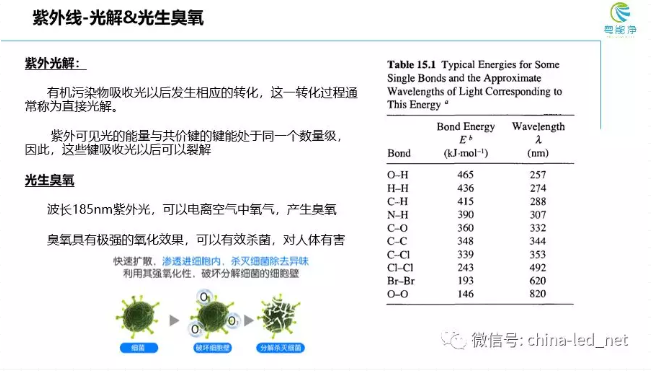
The UVC band of ultraviolet mercury lamp is mainly concentrated in 254nm and 185nm, because Mercury source can only excite the two wavelengths with high peak value. In the 185nm band, the photolysis effect and photogenerated ozone effect of mercury ultraviolet will appear. Therefore, when the 185nm ultraviolet lamp is used for sterilization, the effect of photolysis and photogenerated ozone related to the sterilization efficiency of the light source's wavelength will appear. Therefore, it is sometimes difficult to distinguish whether the 185nm mercury lamp is sterilized by light source, photolysis or photogenerated ozone.
However, it is certain that the shorter the wavelength is, the greater the energy of the light wave is, the greater the attenuation efficiency will be, so the ability to work over a long distance will be weaker.
Comparison of UV purification technologies
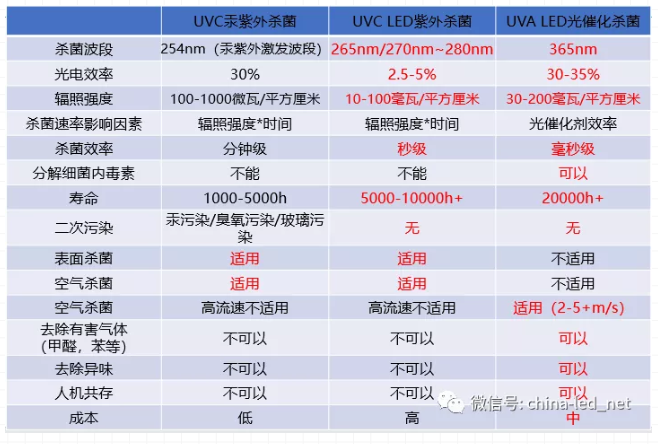
4、 Market application of UVA led photocatalysis
UV LED has brought great technical advantages to photocatalysis. The energy intensity and energy density have been improved by more than one order of magnitude, and the unit area has reached 450 MW / cm2 without any problems.
Technical advantages of uva-led for photocatalysis
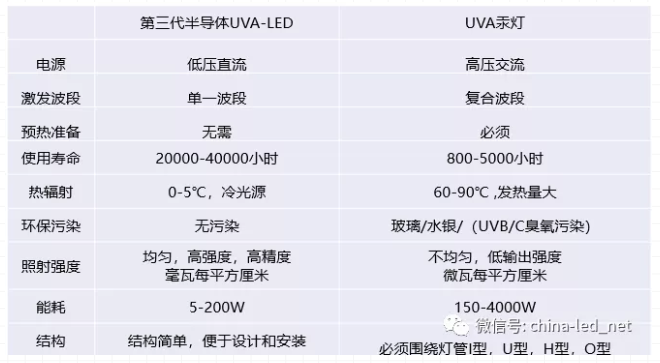
The photocatalysis technology of the third generation semiconductor technology with low power and high photoelectric efficiency narrow band UVA led ultraviolet light source has many advantages
It has the advantages of broad sterilization, strong ability, no drug resistance and complete decomposition; complete mineralization of toxic organic matters can be efficiently degraded; high efficiency and long service life; simple maintenance and low operation cost; no pollution, non-toxic, health and safety, and environment-friendly.
Net demand analysis
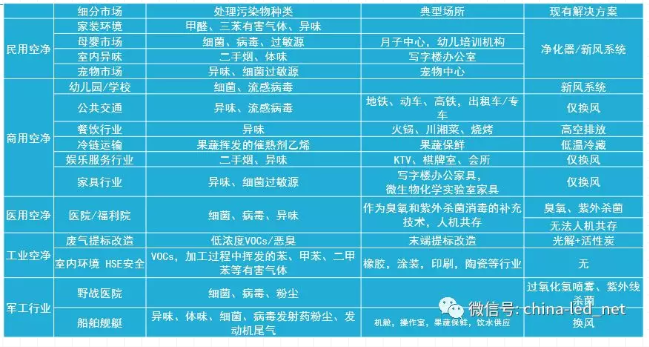
According to our experience, we can simply divide the air purification market into civil, commercial, medical, industrial and military industries. There are different purification requirements in different application scenarios, and many existing solutions and solutions can not solve the problem. You can refer to your own experience.
In general, the ultraviolet light source based on the third generation semiconductor materials has brought new changes to the whole photocatalytic technology. For example, from the perspective of light source energy, it has brought an order of magnitude improvement; its life span and environmental safety performance have been greatly improved; new opportunities have been brought to the research and application of photocatalysis; the huge industrial market of environmental protection and health and virus epidemic prevention has been prized; the elimination of backward materials and technologies (mercury, activated carbon, etc.) has brought a solid technical foundation.
Application of photocatalytic technology
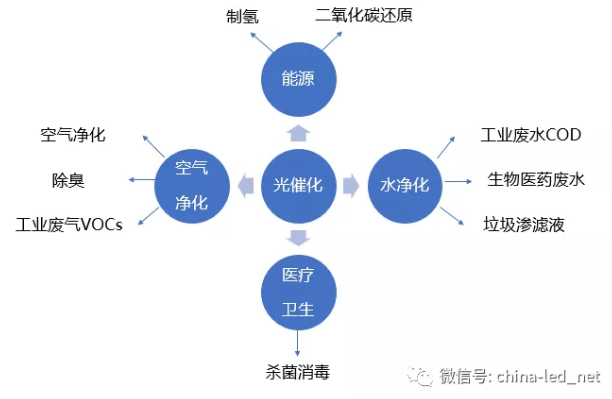
Guangdong yuenengjing Environmental Protection Technology Co., Ltd
The company has independent intellectual property rights, research and development and preparation of new environmental protection materials, design and manufacture of new environmental protection equipment of high-tech environmental protection enterprises.

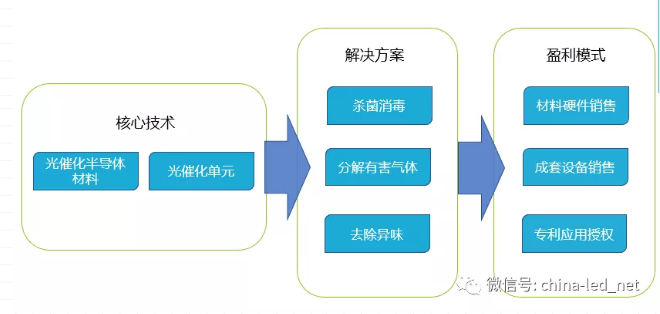
Q & a session
1. For the control of ozone concentration, what are the standards for ozone concentration in each cited environment?
Zhang Hao: we can refer to the national standard gb21551.3-2010 special requirements for air purifiers with anti bacteria, anti bacteria and purification functions for household and similar electrical appliances, and the test methods and requirements for ozone concentration and UV leakage concentration can be referred to. Our test data show that photocatalysis does not produce ozone under UV light source. Third party reported safety testing can also be verified.
2. What is the consumption of photocatalyst? Is it a consumable?
Zhang Hao: the characteristic of the catalyst is that it does not participate in chemical reactions, it only affects the reaction rate, so it is not consumed. However, many catalysts will be poisoned or invalid in the process, which is related to the operating conditions. Some catalysts are used at high temperature and high pressure. In these cases, there may be other physical and chemical reactions in them, which will lead to the deactivation of catalytic properties.
3. Can the photocatalytic efficiency be improved by increasing the intensity of UVA?
Zhang Hao: UVA light source and catalyst can be understood as the relationship between tools and workers. If you use UVA led alone with UV mercury lamp, the amount of tools is different by many orders of magnitude. For ease of understanding, for example, if you think of a catalyst as a worker, if there are only ten workers on the surface of the catalyst, and if you use a UV mercury lamp, you can only give one tool per unit time, then there will be nine workers who can't work without tools. But if you use UVA light source, you can give 10 tools per unit time, and all 10 workers can work completely.
However, if the intensity of the light source is further increased, 100 tools can be given to 10 workers per unit time, however, the number of workers is limited. Therefore, if the light source is supersaturated for the catalyst, the effect of temperature and lifetime brought by the increase of light source power will not be worth the loss.
Catalyst and light source need to match, first of all, quantitative, secondly, on the basis of quantitative, increase the amount of catalyst under the effective light irradiation area, and also improve the irradiation uniformity and radiation intensity under the effective area, which are complementary.
4. UVA LED is widely used in medical cosmetology. What is the best wavelength for UVC led sterilization? Can led package be 254nm now?
Zhang Hao: the most widely used market of UVA LED is light curing. The nail lamp is related to the beauty market, followed by the money detector factory. The best sterilization wavelength is between 260nm and 275nm. The reason why there is 254nm is that the peak wavelength of UVC band excited by mercury light source is only 254nm, but this is not to say that 254nm is the best.
5. Is ozone or UV better?
Zhang Hao: from the quantitative effect point of view, the difference between the two is not particularly big, but the actual use is related to the characteristics of these two. UV sterilization, only useful for the exposed surface. If you want to sterilize, you have to light where you can. The characteristic of ozone is that it can fill the whole space and kill it. Although ozone has advantages, it can stimulate the upper respiratory tract very much, and it is easy to become cancerous. Ozone is also one of the other pollutants stipulated by the state, which has advantages and disadvantages. When using it, the space must be closed.
6. does novel coronavirus pneumonia spread through aerosol and does photocatalytic prevent it?
Zhang Hao: we can't directly say that photocatalysis has an effect on aerosols. Gaseous particles include dust. If the particle size is less than 2.5 μ m, it is easy to suspend in the air. If the particle is only solid dust, it is very simple that it is only particulate matter. However, in the case of small particles, such as formaldehyde, after combining with dust or water molecules in the air, can form aerosols, which are easy to spread around through the air.
The principle of photocatalytic purifier is very simple, which is to let the air contact the catalyst actively through the circulation of large air volume, and then decompose through the catalyst. If there is formaldehyde in the air and the aerosol contains bacteria or viruses, the concentration of aerosol can be reduced in an enclosed environment, but it can not be removed 100%.
Second, the concentration of bacteria and viruses in aerosol is limited. After the human body is infected, to reach a certain limit, a certain magnitude will have the infectious effect. The use of photocatalysis technology can ensure that the aerosol in the air can reach a relatively low level in the process of dynamic equilibrium, thus reducing the possibility of pollution in disguise.
7. What is the effective distance of hydroxyl radical produced by UVA irradiation photocatalyst? Has the 30 cubic meter warehouse test been done? If the distance is longer, can the sterilization effect be achieved?
Zhang Hao: hydroxyl radicals are produced by photocatalytic decomposition of water in the air. In the air, hydroxyl radicals cannot be free from the surface of the catalyst. At present, there are some methods to quantify hydroxyl radicals.
When you do the gas chromatography, the humidity is actually 0%. After testing, it was found that photocatalysis can have good oxidation effect without producing hydroxyl radicals, because electron hole oxidation effect is very high, but there is no means to quantitatively test the oxidation effect of electron hole.
Our experience is that the air exchange efficiency becomes higher, which can increase the amount of gas passing through the photocatalytic materials per unit time and improve the effect. However, if you want to take the initiative to kill bacteria through hydroxyl group, the oxidation capacity of hydroxyl group is higher than that of ozone, which will certainly hurt people, so the theory and practice are not feasible. The hydroxyl group does not leave the catalyst in air and can leave in water, but it can survive for a short time.
8. With the use of photocatalysis, will the efficacy be reduced? How to judge?
Zhang Hao: according to the actual experience and the condition of aging equipment, there will be attenuation after a long time. Because under the laboratory conditions, it can ensure that the air components of the experimental warehouse are very clean and pure, but the actual application situation is very complex, there are water, bacteria, natural bacteria, viruses, formaldehyde and so on in the air, there are many factors affecting each other, it is difficult to exclude.
In a word, the main factors affecting the photocatalytic efficiency are the light attenuation of the light source. If the active change reduces the electric power, the light source will decay to unsaturated state under the condition of supersaturation, and the photocatalytic efficiency will be reduced. Second, if the particle dust protection is not done in the actual use, the dust can be seen on the catalyst surface under a high power (500-700 times) microscope for a long time, which may seriously block the catalyst surface, or even cause the catalyst to change color, which will affect the efficiency.
According to the aging equipment in about two years, the formaldehyde decomposition efficiency of the new equipment may be in the range of 92% ~ 95% in one hour, and the retest effect can reach more than 80% after one year of use. (the text is edited and arranged according to the live broadcast content, with slight deletion)
Zhang Hao: evaluation and application of UVA led photocatalysis technology for air sterilization and disinfection
Industry News · February 15, 2020 · 1508 views
Hubei Shenzi Technology has obtained AEC-Q102 automotive grade certification, defining automotive grade UVC LED applications ..
Company News · May 26th · 26 views
We sincerely invite our partners to visit Shenzhen light Expo
Company News · August 30, 2018 · 262 views
"Little sun" ranks first in the world and can eliminate 99.99% bacteria in water purifier
Media Report · February 3, 2018 · 528 views
Cool summer vacation -- a group trip to Lushan Mountain of DUVTek
Company News · August 6th, 2018 · 258 views
DUVTek was selected into Ezhou science and technology plan project in 2021
Company News · December 27, 2021 · 267 views
UV can detect cancer by DNA imaging cell technology
Technical Sharing · November 17, 2017 · 339 views
Distinguished youth, Changjiang Scholar, Professor Lu Hai of Nanjing University and his party visited our company
Company News · April 25, 2018 · 717 views
